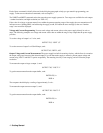Getting Started
42
Each of these commands is briefly discussed in the following paragraphs to help you get started in programming your
supply. To know more about these commands, refer to Chapter 5.
The VRSET and IRSET commands select the range the power supply operates in. Two ranges are available for each output
- standard resolution, and high resolution (see Table 1-2).
If the value for voltage or current entered is not within the present operating range of the supply, the error annunciator will
indicate an error. Sending ERR?, and addressing the supply to talk, will return the error message (in the case ’’number
range" error would be displayed.
Voltage and Current Programming. You can send voltage and current values to the power supply directly in volts or
amps. The following examples use voltage and current values that are within the range of any output that the power supply
provides.
To set the voltage of output 1 to 5 volts, send:
OUTPUT 705; “VSET 1,5”
To set the current of output 2 to 450 milliamps, send:
OUTPUT 705; ''ISET 2,.450"
Output Voltage and Current Measurement. The power supply has built-in metering circuitry, which allows it to monitor
the output voltage and current of the selected output. You can instruct the supply to return its present output voltage and
current using VOUT? and IOUT? queries respectfully. The metering circuitry is auto-ranging, and will select the proper
resolution.
To measure the output voltage at output 1, send:
OUTPUT 705; "VOUT? 1"
To get the measurement from the output buffer, send:
ENTER 705; A
DISP A
The computer should display a reading of approximately 5 volts .
To measure the output current at output 2, send:
OUTPUT 705: "IOUT? 2''
To get the measurement from the output buffer, send:
ENTER 705; A
DISP A


















